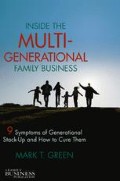Abstract
It used to be that we worked too hard. In the fast growth of the 1980s and 1990s, long hours at the office became a badge of commitment to the company, one often associated with promotions and other perks. People, especially men, routinely chose career over time with family and friends, and job responsibilities over hobbies. Such workaholism is still alive and well in many quarters of the United States and other countries—careers like banking and consulting are notorious for their combination of high compensation and challenging lifestyles. But there has been a growing backlash to the notion of “live to work,” and today many professionals have turned that phrase on its head: they wok to live, enjoying multiple aspects of life outside the office. This has become a hallmark characteristic of Gen X. Their quest for balance is admirable, and has resulted in many benefits like higher quality family time and better physical fitness (for some of us). But it also creates challenges; when work responsibilities take a back seat to other pursuits, productivity can suffer, and tension regarding roles and responsibilities can arise. In family businesses, the issues can be even more complicated, as there are often fewer “hands on deck,” meaning that the unavailability of any given person causes bigger problems; moreover, different generations often have very different perspectives on work-life balance, resulting in clashes.
Access this chapter
Tax calculation will be finalised at checkout
Purchases are for personal use only
Preview
Unable to display preview. Download preview PDF.
Notes
Lynne Lancaster and David Stillman, When Generations Collide. New York: HarperCollins, 2002.
Alison Damast, “MBA Job Outlook Improving,” Bloomberg Businessweek, February 3, 2010 (http://www.businessweek.com/bschools/content/feb2010/bs2010021_018515.htm) (accessed May 17, 2010).
Bureau of Labor Statistics, “Economic News Release: Employee Tenure Summary,” September 26, 2008 (http://www.bls.gov/news.release/tenure.nrO.htm) (accessed May 17, 2010).
Shirleen Holt, “Workaholics Glad to Labor While Others Play,” Seattle Times, September 4, 2004 (http://seattletimes.nwsource.com/html/businesstechnology/2002027666_doers06.html) (accessed May 17, 2010).
Lynne Lancaster and David Stillman, When Generations Collide. New York: Harper, 2002.
Copyright information
© 2011 Mark T. Green
About this chapter
Cite this chapter
Green, M.T. (2011). Comfortable Gen X. In: Inside the Multi-Generational Family Business. A Family Business Publication. Palgrave Macmillan, New York. https://doi.org/10.1007/978-1-137-51101-0_9
Download citation
DOI: https://doi.org/10.1007/978-1-137-51101-0_9
Publisher Name: Palgrave Macmillan, New York
Print ISBN: 978-0-230-11184-4
Online ISBN: 978-1-137-51101-0
eBook Packages: Palgrave Business & Management CollectionBusiness and Management (R0)

